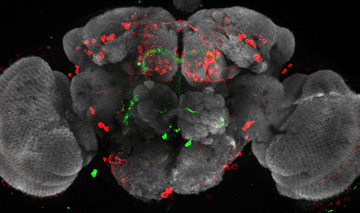Fight control: Researchers link individual neurons to regulation of aggressive behavior in flies

(Medical Xpress)—Scientists have long pondered the roots of aggression—and ways to temper it. Now, new research is beginning to illuminate the cellular-level circuitry responsible for modulating aggression in fruit flies, with the hope of someday translating the findings to humans.
Researchers at Harvard Medical School have identified two pairs of dopamine-producing neurons, also called dopaminergic neurons, and traced their aggression-modulating action to a common structure in the fly brain called the central complex, suggesting that important components of aggression-related behaviors may be processed there.
"This is the first research to identify single dopaminergic neurons that modulate a complex behavior—aggression—in fruit flies," said Edward Kravitz, George Packer Berry Professor of Neurobiology at HMS and lead author of the study.
"We don't know how complex this modulatory circuit is, but we now have a key element of it. If we eliminate or increase the function of that dopaminergic neuron, it affects the circuit of the brain responsible for controlling aggression," Kravitz said.
The findings were published last week in PNAS.
Flies are an ideal animal model for neurological research because genetic methods allow scientists to manipulate neurons and simultaneously observe the resulting behaviors. Many fundamental nervous system mechanisms in flies are similar to those in humans. In fact, both flies and humans share the same neurohormones.
Dopamine is one such neurohormone, and across species it affects a range of behaviors, from learning and memory to motivation and movement. In humans, neurohormones are associated with conditions such as Parkinson's disease and psychiatric disorders.
Dopaminergic neurons are found in small numbers in particular parts of nervous systems. In humans, there are about 200,000 to 400,000 of these neurons; in fruit flies there are about 100. While their numbers are few, these neurons influence a vast array of behaviors.
Kravitz, along with Olga Alekseyenko, a postdoctoral fellow in the Kravitz lab and first author on the paper, set out to discover how these few dopaminergic neurons can influence such a wide range of behaviors.
To do this, study co-first author, Yick-Bun Chan, HMS research associate in neurobiology, genetically engineered 200 lines of fruit flies. He then used them to target select dopaminergic neurons that could be activated or silenced while the flies engaged in various behaviors.
The team detected two pairs of dopaminergic neurons that affected aggressive behavior in the flies. Interestingly, aggression was increased in the flies either by augmenting the function of these cells or by deactivating them.
In fruit flies, males fight for territory and form stable hierarchical relationships. Using previous observations and analysis of more than 20,000 interactions in fly fights, the team established quantitative measures of aggressive behavior, such as lunging, that allowed them to compare aggression levels in different fly attacks.
"When we turned off the pairs of dopaminergic neurons, the flies fought with more lunging; when we turned them on, they also fought at higher intensity levels. Apparently normal levels of aggression require a precise amount of dopamine released at a specific time and place in the nervous system. These results suggest that these neurons ordinarily hold aggression in check," said Alekseyenko.
Also significant was the finding that while the two sets of dopaminergic neurons modulated aggression, they did not influence other behaviors.
The first pair of neurons are found in the PPM3 cluster of neurons in the fly brain and the second are within the T1 cluster. Both pairs innervate different parts of the central complex, an important structure in the fly brain.
"We already knew that dopamine receptors are present in the central complex, but we didn't know which dopamine neurons connected to the receptors or what behaviors those neurons affected," said Alekseyenko.
"Now we know that two pairs of aggression-mediating dopaminergic neurons terminate in different regions of the central complex, and we know that those regions have different types of dopamine receptors. Our study shows that aggression is one of the behaviors coordinated in these regions of the brain, but we still don't fully understand the process," he said.
In a third group of flies, a neuron pair that projected into a different part of the brain was identified. These neurons affected locomotion and sleep, but did not influence aggression.
Kravitz said the next phase of the research will be to use genetic tools to allow his team to identify the subsequent steps in the brain circuitry—which neurons are pre- and post-synaptic to the T1 and PPM3 neurons and how that affects neuronal network function.
The goal will be to establish fundamental principles for how dopaminergic neurons work in the fruit fly system, with the hope that the research will one day translate to how these neurons work in higher species. This may ultimately aid in the development of new dopamine-targeted medications for humans.
"We can now relate these two pairs of neurons specifically to one behavior, and that is aggression," Kravitz said. "That means we have one piece of the puzzle."
More information: www.pnas.org/content/110/15/6151.abstract
















